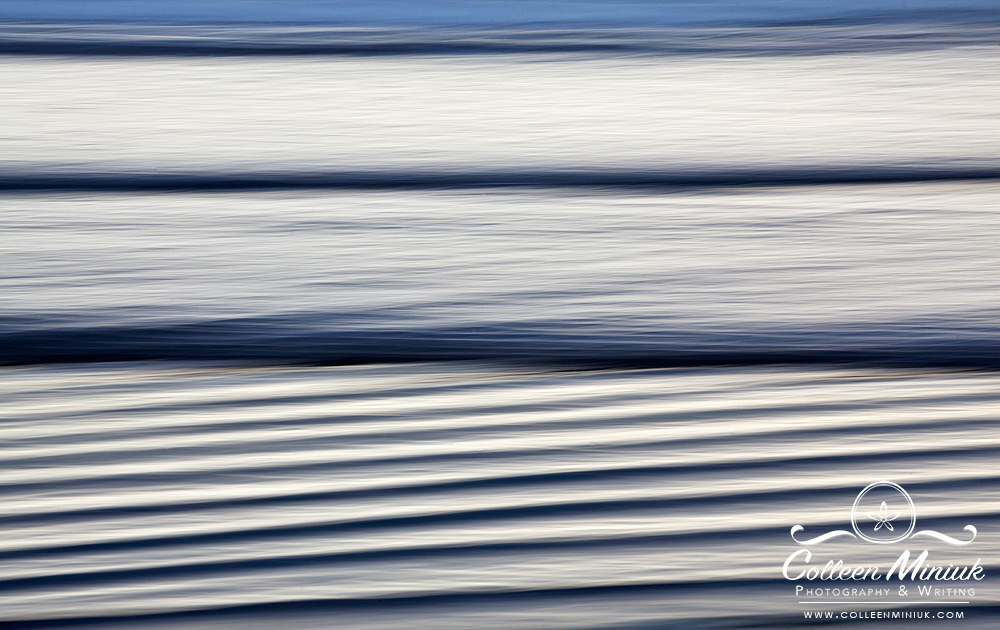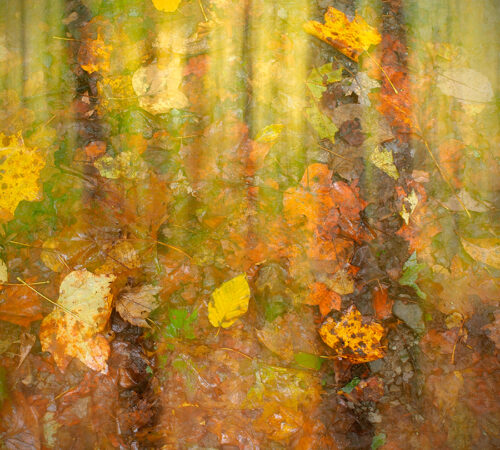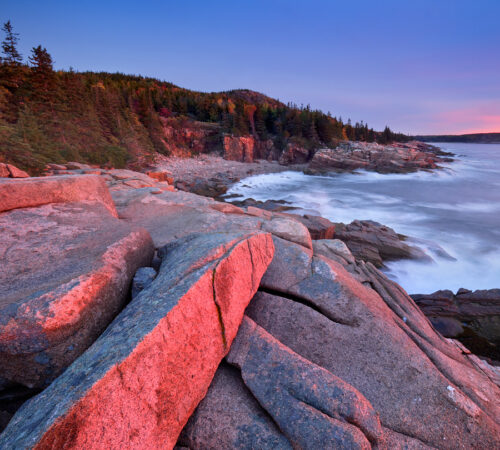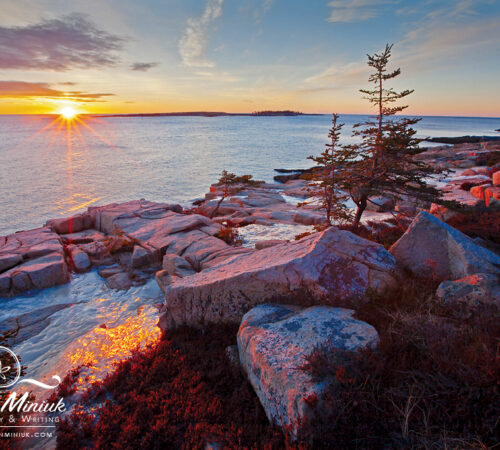Lust of the Mind

Dear Bubbles:
Freeman Patterson said, “There’s only one rule in photography—never develop color film in chicken noodle soup.” Discuss.
~Guy
Dear Guy,
Freeman Patterson, who lives in New Brunswick, Canada, is one of my favorite modern-day nature photographers. I received one of his beautifully-done books, specifically Photography and the Art of Seeing: A Visual Perception Workshop for Film and Digital Photography (Third Edition) as a gift from a friend many moons ago. It wasn’t like any other photography book I had read. Of course, his intimate and expressive images moved me. (It didn’t hurt that the cover featured colorful bubble-like shapes…just sayin’). What really impressed me, though, was his insightful discussion of concepts like “thinking sideways,” “relaxed attentiveness,” “expression,” and “visual design.”
These were foreign, yet refreshing ideas for me back then, when I was a developing over-analytical, type A, perfectionistic photographer with a propensity to strictly follow the checklist of rules for every photograph, come hell or high water. He didn’t mention any rules at all in his book. He made me want frolic among fields, laugh with the butterflies, and feel the delicious freedom in expressing my wonder and delight about the world through my photography. Mr. Patterson made photography sound really fun! I’ve since followed his work. Even today at 83 years young, Mr. Patterson continues to make thoughtful and engaging photographs that inspire me.
Considering this and what I’ve gleaned from his photography, background, and philosophies over the years, it surprised me to hear that Mr. Patterson had any rules of photography. I did some digging to confirm and found that he, in fact, expressed this notion at least once during an interview with Chris Maher and Larry Berman in 2001 (a fabulous read, by the way: http://bermangraphics.com/press/patterson.htm). In it, he said, “In fact, I only have one rule. That is never process your film in mushroom soup…”
Regardless of flavor, rules are a set of governing principles. In many cases, they guide us into making good life decisions based on a shared set of values. They lead to stability and peace in our society. Laws in science help us understand and describe the world around us. In visual work, we consult design principles to help make aesthetic choices for our compositions. For example, if you wish to create shape in a two-dimensional photograph, incorporating a combination of lines, layers, and light helps to deliver the illusion of a third dimension.
But nothing in art or photography (at least that I’ve found) says you must render a third dimension in a two-dimensional media. Art has no rules. As famed artist Christo said, “The work of art is a scream of freedom.”
I’m sure at some point The Great and Almighty Gods of Photography—the internet—instructed us to create depth in our photographs or we’ll spontaneously combust in the same way they’ve predicted a similar outcome if we center a primary subject or stack filters. When I first started learning photography, I interpreted the well-intentioned, but oversimplified, advice such as this as non-negotiable. In doing so, I hoped I’d become a more proficient photographer. To a certain extent, I did. I became proficient in rule following which led to technically perfect pictures, but uninspiring ones. After learning the “rules” and how to apply the rules successfully, I couldn’t figure out where I had gone wrong–or what to do about it. I mean, after you learn to put your primary subject in one of the four intersection points of the Rule of Thirds tic-tac-toe grid in your picture, what else are you supposed to do? Where do you go from there? How does one do more or better Rule of Thirds?
Mainly out of boredom and frustration, I started questioning the so-called “rules of photography.” Anytime I heard or read a statement of limitation, such as the one Mr. Patterson offered up, my brain flipped into curiosity mode (and still does). If someone tells me I should or shouldn’t do something with my photography (or life), I ask “Why?” (and its close cousin, “Why not?”) and “What if…”. In other words, my mental state regresses into a child-like state.
Why shouldn’t I center my primary subject? Why shouldn’t I stack filters? And why shouldn’t I process film in soup? Why? Why? Why?!
In examining everything, I learned not just what to do and how, but when and why. I also discovered new and exciting ideas. For example, my understanding of “how to do Rule of Thirds better” (which I actually Googled during my struggles…) led to expanding my knowledge of Gestalt psychology and human perceptions. Photography was no longer about laboriously conforming to a checklist, but rather entailed a series of deliberate decisions to be made based on what I wanted to accomplish in my individual expressions. There were so many options, so many right answers. This not only changed how I approached my work, but it also enabled me to produce photographs I finally liked, ones I thought truly conveyed the freedom I felt as an artist to express exactly who I was, how I felt, and how I hoped the external world responded after seeing my work.
In podcast interview in 2016, I was asked, “What would you consider the most important practice to your photography? (Something that stands out to be important for every job or project)” I said: “My most important practice is to approach photography, whether shooting or working on a business proposal, with curiosity.” I still believe this to be true today. In my humble opinion, being curious about the world, not just photography, is one of the most important ingredient in making creative, expressive photographs. Not expensive equipment. Not even polished technique. But rather the willingness and courage to ask questions of everything, including, and especially, anything someone calls a “rule” of photography or art.
The great news? Curiosity is free, and you already possess it. It is an innate behavior in human beings. It’s something we’re born with. Everything starts off as new to us as babies. Exploring the world through sight, touch, taste, sound, and smell is how we learn, set boundaries, make decisions, develop likes and dislikes, establish connections with other human beings, among other things. Astrophysicist and author Mario Livio describes two types of curiosity in his book, Why: What Makes Us Curious:
- Perceptual: aroused by “…novel, ambiguous, or puzzling stimuli, and it motivates visual inspection…” Once satisfied, engagement diminishes. How many of you have rubbernecked on the highway at a car wreck? You don’t want to look, but you do…and once you do, the curiosity passes, and you move on with your life. (This specific situation is further classified as “morbid curiosity.”)
- Epistemic: the insatiable desire for knowledge. Philosopher Thomas Hobbes called this “lust of the mind.” Two driving forces behind this type of curiosity are, one, interest and intrigue and/or, two, avoiding boredom.
Being curious isn’t always appreciated, though. Growing up, some teachers were quick to scold students who asked too many questions in class. It didn’t stop there. As recently as last fall when I asked “Why” in a course, demanding a deeper understanding than what was being presented, the instructor eventually rolled his eyes and said, “Because that’s just the way it is.” (Not satisfied with that answer, I did my own research on the topic and figured it out on my own. It’s hard having an 8-year-old mind trapped in a 45-year-old body! #firstworldproblems)
To question is to venture into the unknown and uncertain (for both the examiner and the examined). It challenges beliefs and assumptions, sometimes long-standing ones. It requires one to accept that what we currently do or know may not be true, right, or optimal. One cannot be afraid to fail or fear facing other negative consequences from the inquisition. One must possess an open mind, one free of judgment, for what new knowledge and opportunities might transpire. If we wish to be more expressive and creative with our photography, I believe it’s required.
I’ve previously established in earlier posts that our ability to create expressive nature photographs relies upon the existing information in our minds. (For a refresher, read Keeping it Fresh). The first step of the Wallis model of creativity, Preparation, or filling your brain with knowledge and ideas, demands curiosity if we have any hope of facilitating the “aha” moment and creating something new. So long as you thirst for knowledge–and have the courage to seek it by asking questions–you’ll never run out of raw materials to use in your own photography.
What does this mean practically? Learn about cameras, photography techniques, creativity, art, the behavior of your subjects, places, history, culture, geology, flora, fauna, and yes, even soup–whatever gets you excited and more curious about the world around you–even if you have no idea how to incorporate it into photography at the time. Challenge yourself to create connections between unrelated things while you’re sitting on your couch or in the field (e.g. conceptual blending, metaphorical associations). Visualize absurd and strange ideas (without judging them as absurd and strange). Force yourself out of your habits, even if they are working for you. Ask others why they did what they did in their photographs. Seek out new experiences. Observe. Play. Test. Value the questions over the answers. When you stumble upon answers, ask more questions. Make life one big treasure hunt.
The photograph at the top of the post derived from asking a simple question: “What if I made a photograph of a moving object, the ocean waves, by moving the camera from side to side in a panning motion during a longer exposure?” Before then, I had only used this technique with stationary subjects. (After all, rules say we should always photograph from a tripod, right? Yeah, about those things called “rules…”) I had no idea what would happen. Worst case scenario, I accidentally fling my camera into the ocean. (Thankfully that didn’t happen.)
I flipped through various shutter speeds and ISOs. I moved the camera really fast in one frame, then really slow on the next. I moved the camera straight across, then sideways, then in a circle. I waited for really big waves. I followed foam trails in the sand left behind by smaller ones. At the time, I didn’t even care if a single image turned out. I was having the time of my life playing and experimenting and discovering and screwing up, squealing with delight when something interesting flashed on my screen (like the above photograph) and laughing at myself when things didn’t turn out. I ended up making 181 images in about 45 minutes, including this one (ISO 100 at f/20 for 0.6 sec.). More importantly, I learned something about my craft, movement of water, and my interests and style with this type of technique–information I incorporate into my work today.
This is just one of many examples. I’ve asked what would happen if I put my shower cap over my lens and shot through it (and now it’s my “ethereal filter!”). The Dear Bubbles weekly column resulted from a “what if…” and “why not…” train of thought. Curiosity isn’t limited to my artistic pursuits. It’s how I live my life. What if I took that dirt track? What if I went to Death Valley when it’s 124F? What I stood in a blizzard with 85 mph winds? What if I stand-up paddle board across the largest reservoir in the United States? I’ve done all these. Asking questions like these has helped me piece together a tremendously rich and rewarding life, one far better than I could have put together simply by following a bunch of “rules” someone on the internet made up.
Now, I’m not suggesting we throw out or ignore all rules and become a lawless society. I’m not suggesting you question why robbing a bank is illegal. I’m encouraging you to see through opinions dressed up like rules when it comes to your creative pursuits. You can spot these by incorporating simple questions like “Why,” “Why not,” and “What if” into your photographic process. In doing so, it’ll help you move beyond the limits of what many have told us is impossible and into exploring what is truly possible.
In that vein, let’s get back to the earlier questions I posed:
Why shouldn’t I center my primary subject? Research in human perceptions has shown that viewers perceive objects centered in a frame to be at rest, stable, not moving. If you have a subject that you wish to depict is at rest, stable, and not moving, you’d center it on purpose. (You won’t spontaneously combust, I promise.) If you wish to convey a dynamic, high energy subject you wouldn’t center it since your viewers will perceive it otherwise. The choice is yours, but chose wisely and for effect.
Why shouldn’t I stack filters? Stacking multiple sheets of acrylic and/or glass affects how light will transmit to your sensor/film. It can affect the image quality, clarity, and sharpness (but oftentimes not noticeably enough to warrant not stacking filters). It can also cause lens flare, vignetting, color shifts, and other undesirable effects. That doesn’t mean you shouldn’t stack filters. Just be aware of what happens when you do, understand the risks (which are minimal by all measures), and address any issues you see. I stack filters all the time. I have yet to spontaneously combust.
Why shouldn’t we process film in soup? I understand the chemical process for both color and black and white development, having done both at one point or another in my career. I get it. Even a cursory evaluation of this idea will lead you to conclude neither chicken noodle nor mushroom soup contains the necessary transformative elements to convert a sheet of exposed film into a negative (or positive). But what if we didn’t expect it to? What if we ran the experiment without anticipating a certain outcome (i.e. that something other than C41 was capable of developing color film successfully)? What would happen if you processed film in soup? Would pineapple juice work better? How about gin? Had I not sold off all of my darkroom equipment years ago, I assure you I would find out. I have spent the last week visualizing the possible process in great detail, though, and it’s been all sorts of awesome. Besides being an entertaining exercise, it’s reminded me of how much I enjoyed working in the darkroom, watching my print come to life in the developer under the intoxicating smell of fixer. Ahhhh, the good ‘ole days…
If you recall the beginning of this discussion, I immediately questioned the notion Mr. Patterson had any rules and did additional research to confirm. In doing so, I learned that the original quote wasn’t Mr. Patterson’s full statement. Turns out, it was “In fact, I only have one rule. That is never process your film in mushroom soup, because it doesn’t work.”
Is this then truly a “rule” or seasoned advice in hopes of preventing disappointment (an emotion that only results because we hold onto the expectation soup could work)? Instead of a rule, I’d call his statement an open invitation to explore other possibilities and discover more about our tools and techniques. And I have. In following my nose on processing film in soup, I found a way to process black and white film using instant coffee instead of the standard chemicals: https://www.fieldmag.com/articles/how-to-develop-film-with-coffee-caffenol-guide.
I also discovered this gem: in 1944, a three-year-old girl asked her father why she had to wait to see the photograph he had just made of her. Four years later, as a result of that question, Edwin Land invented the Polaroid instant camera and film. The truth of the matter is that if someone hadn’t been curious about what happened to light when it is projected through a small hole many centuries ago (called “camera obscura”), we might not be talking about photography at all today.
As Albert Einstein said, “The important thing is to not stop questioning. Curiosity has its own reason for existence. One cannot help but be in awe when he contemplates the mysteries of eternity, of life, of the marvelous structure of reality. It is enough if one tries merely to comprehend a little of this mystery every day.”
What will you be curious about today?
Be well, be wild,
~Bubbles
Have a question about photography, art, and/or the creative life? Need some advice? Send your question to Dear Bubbles at colleen@colleenminiuk.com to be possibly featured in a future column post. (If you’d prefer a different display name than your real first name, please include your preferred nickname in your note.)





3 Comments
Barry Wolf
Excellent comments. I would posit that a lack of curiosity and desire to challenge one’s beliefs and are learn is the major problem for society in general today. If I hadn’t been curious, lacked a desire to learn and willing to challenge my beliefs, I would not have evolved into the person that I am today. It frightens me to realize how many people are too afraid to do all these things and to grow and prefer to stay in one place.
Bubbles
Thanks, Barry! I couldn’t agree with your comments more. Curiosity can benefit more than just photographers…and the world would be a better place if more people felt confident in following theirs. Hope all is well with you!
Pingback: